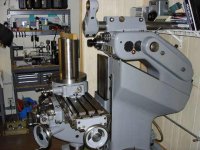trafficbikes
Plastic
- Joined
- Jan 21, 2009
- Location
- New York
I'm going tomorrow to pick up a new (used) Abene mill - my first big machinery purchase. It's in pretty good condition - no slop in the ways, relatively clean, table in good condition, etc. There's some backlash on the feedscews that I'd like to get rid of, and I'm not sure the coolant pump or light work, and the ways are kinda gummed up. I also don't have a phase converter, and need to get an electrician out to wire one up, etc.
Oh - photos here.
So, questions:
Cleaning the ways & Bijur lube system: Do I get a pail of kerosene and a big pair of gloves and go at it? Try to flush out the lube system too? Scotch-brite pads? Scrapers? Should I take the table apart to really clean everything out? I don't think it's that bad as-is, but I'm probably never going to clean it in the future.
Backlash in the feedscrews: My limited understanding tells me that you can adjust the feedscrews to eliminate backlash. How is this done? Eventually I'd like to put a DRO on it, but for now some precise feedscrews would be good.
Phase converter: It's a 5hp spindle with a 2hp feed and a .06hp coolant pump. That means I need a 7.5hp phase converter, and TEMCo says I should use their 6500-11KW, which is a "medium load" converter. Is that accurate? Anyone have experience running an Abene on a smaller phase converter?
Light & Coolant pump: The coolant pump must run off the main power; does the light have a separate power supply?
I hear these machines are great, and I'm looking forward to having one of my own!
Spencer Wright
Traffic Cycle Design
http://trafficbikes.com
Oh - photos here.
So, questions:
Cleaning the ways & Bijur lube system: Do I get a pail of kerosene and a big pair of gloves and go at it? Try to flush out the lube system too? Scotch-brite pads? Scrapers? Should I take the table apart to really clean everything out? I don't think it's that bad as-is, but I'm probably never going to clean it in the future.
Backlash in the feedscrews: My limited understanding tells me that you can adjust the feedscrews to eliminate backlash. How is this done? Eventually I'd like to put a DRO on it, but for now some precise feedscrews would be good.
Phase converter: It's a 5hp spindle with a 2hp feed and a .06hp coolant pump. That means I need a 7.5hp phase converter, and TEMCo says I should use their 6500-11KW, which is a "medium load" converter. Is that accurate? Anyone have experience running an Abene on a smaller phase converter?
Light & Coolant pump: The coolant pump must run off the main power; does the light have a separate power supply?
I hear these machines are great, and I'm looking forward to having one of my own!
Spencer Wright
Traffic Cycle Design
http://trafficbikes.com




